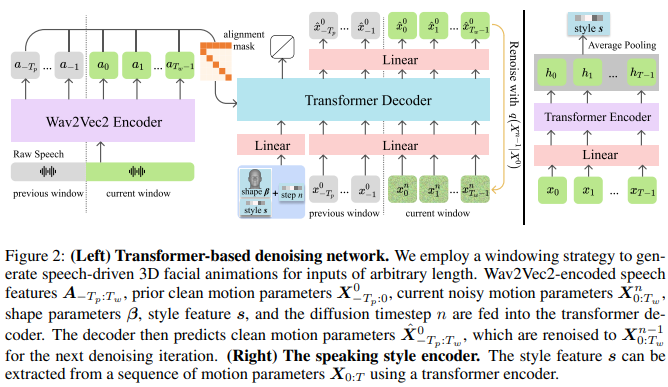Speech-based expression animation, a complex problem at the intersection of computer graphics and artificial intelligence, involves generating realistic facial animations and head poses based on spoken language. The challenge in this area arises from the intricate many-to-many mapping between speech and facial expressions. Each individual has a different speaking style and the same sentence can be articulated in numerous ways, marked by variations in tone, emphasis and accompanying facial expressions. Additionally, human facial movements are highly complex and nuanced, making creating natural-looking animations solely from speech a formidable task.
Recent years have witnessed researchers exploring various methods to address the intricate challenge of animating speech-based expressions. These methods typically rely on sophisticated models and data sets to learn the intricate mappings between speech and facial expressions. While significant progress has been made, there is still vast room for improvement, especially in capturing the diverse and natural spectrum of human expressions and speaking styles.
In this area, DiffPoseTalk emerges as a pioneering solution. Developed by a dedicated research team, DiffPoseTalk leverages the formidable capabilities of diffusion models to transform the field of speech-based expression animation. Unlike existing methods, which often struggle to generate diverse, natural-looking animations, DiffPoseTalk leverages the power of diffusion models to meet the challenge head-on.
DiffPoseTalk takes a diffusion-based approach. The feedforward process systematically introduces Gaussian noise into an initial data sample, such as facial expressions and head postures, following a meticulously designed variation program. This process mimics the variability inherent in human facial movements during speech.
The real magic of DiffPoseTalk happens in the reverse process. Although the distribution governing the forward process is based on the entire data set and is intractable, DiffPoseTalk cleverly employs a denoising network to approximate this distribution. This denoising network undergoes rigorous training to predict the clean sample based on the noisy observations, effectively reversing the diffusion process.

To direct the generation process precisely, DiffPoseTalk incorporates a speech style encoder. This encoder features a transformer-based architecture designed to capture an individual’s unique speaking style from a short video clip. It excels at extracting stylistic features from a sequence of motion parameters, ensuring that the generated animations faithfully replicate the speaker’s unique style.
One of the most notable aspects of DiffPoseTalk is its inherent ability to generate a wide spectrum of 3D facial animations and head poses that embody diversity and style. It achieves this by exploiting the latent power of diffusion models to replicate distribution in various ways. DiffPoseTalk can generate a wide range of facial expressions and head movements, effectively encapsulating the countless nuances of human communication.
In terms of performance and evaluation, DiffPoseTalk stands out. It excels in critical metrics that measure the quality of the facial animations generated. A critical metric is lip synchronization, measured by the maximum L2 error across all lip vertices for each frame. DiffPoseTalk constantly delivers highly synchronized animations, ensuring that the virtual character’s lip movements align with the spoken words.
Additionally, DiffPoseTalk proves very adept at replicating individual speaking styles. It ensures that the generated animations closely reflect the expressions and gestures of the original speaker, thus adding a layer of authenticity to the animations.
Furthermore, the animations generated by DiffPoseTalk are characterized by their innate naturalness. They exude fluidity in facial movements, skillfully capturing the intricate subtleties of human expression. This intrinsic naturalness underlines the effectiveness of diffusion models in generating realistic animations.
In conclusion, DiffPoseTalk emerges as an innovative method for animating speech-based expressions, addressing the intricate challenge of mapping speech input onto diverse and stylistic facial animations and head poses. By leveraging diffusion models and a dedicated speech style encoder, DiffPoseTalk excels at capturing the countless nuances of human communication. As ai and computer graphics advance, we eagerly anticipate a future where our virtual companions and characters come to life with the subtlety and richness of human expression.
Review the Paper and Project. All credit for this research goes to the researchers of this project. Also, don’t forget to join. our 31k+ ML SubReddit, Facebook community of more than 40,000 people, Discord Channel, and Electronic newsletterwhere we share the latest news on ai research, interesting ai projects and more.
If you like our work, you’ll love our newsletter.
We are also on WhatsApp. Join our ai channel on Whatsapp.
![]()
Madhur Garg is a consulting intern at MarktechPost. He is currently pursuing his Bachelor’s degree in Civil and Environmental Engineering from the Indian Institute of technology (IIT), Patna. He shares a great passion for machine learning and enjoys exploring the latest advances in technologies and their practical applications. With a keen interest in artificial intelligence and its various applications, Madhur is determined to contribute to the field of data science and harness the potential impact of it in various industries.
<!– ai CONTENT END 2 –>
 NEWSLETTER
NEWSLETTER





